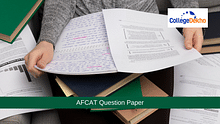The examination of BITSAT includes a total of 40 questions in the Physics section. The BITSAT 2024 Physics Topic-Wise Weightage includes Magnetic Effect of Current & Magnetism (9%), Heat & Thermodynamics (10%), etc.

BITSAT 2024 Physics Topic-Wise Weightage & List of Important Topics -
According to the official syllabus, the BITSAT 2024 Physics syllabus is subdivided into several sub-topics where each of which constitutes a different BITSAT weightage 2024. The section of the BITSAT Physics syllabus consists of 40 questions. As per the previous year's analysis and verdict of the students, BITSAT Physics is considered to be the toughest section amongst the full exam duration of 3 hours.
BITSAT is considered to be one of the toughest engineering entrance exams in India after JEE Main. Birla Institute of Technology and Science Aptitude Test (BITSAT) is an all-India-based admission entrance examination that is conducted for granting admission to eligible candidates into engineering programs offered at the 3 BITS (Birla Institute of Technology and Science) of Pilani, Goa & Hyderabad. Preparing for BITSAT 2024 Physics is a difficult task as the syllabus is vast. However, if you are already through with your preparations for JEE Main, it will be easy to crack
BITSAT 2024
with a good score. In this article, a detailed analysis has been provided of the BITSAT 2024 Physics Topic-Wise Weightage along with the list of most important topics.
Also read:
BITSAT 2024: Important Topics, Major Tips, and Tricks to Score Well
BITSAT Physics Syllabus 2024
The candidates must follow the BITSAT 2024 Physics Syllabus rigorously so that they have clarity before the preparation as well as exams.
Chapter | Topics |
|---|---|
Units & Measurement |
|
Newton’s Laws of Motion |
|
Work and Energy |
|
Gravitation |
|
Optics |
|
Electrostatics |
|
Oscillations |
|
Current Electricity |
|
Modern Physics |
|
Heats & Thermodynamics |
|
Magnetic Effect Of Current |
|
Mechanics of solids and fluids |
|
Waves |
|
Kinematics |
|
Impulse and Momentum |
|
Rotational Motion |
|
Electromagnetic Induction |
|
Electronic Devices |
|
BITSAT 2024 Physics Topic Wise Weightage
Knowing the BITSAT 2024 Physics Topic-Wise weightage is crucial for figuring out the total number of questions that can be asked from a particular BITSAT Physics syllabus 2024. Candidates can find the BITSAT Physics weightage 2024 from the table below -
| Topic | Weightage |
|---|---|
| Units, Dimension, Errors | 3% |
| Alternating Current | 3% |
| Gravitation | 3% |
| Elasticity | 4% |
| Rotational Motion | 4% |
| Work, Power & Energy | 4% |
| Ray Optics | 4% |
| Electrostatics | 5% |
| Simple Harmonic Motion | 5% |
| Wave Optics | 5% |
| Fluids | 5% |
| Wave Motion | 6% |
| Current Electricity | 6% |
| Magnetic Effect of Current & Magnetism | 9% |
| Heat & Thermodynamics | 10% |
Note: The above analyses are made on assumptions from the previous year's question papers. The BITSAT 2024 Physics Topic-Wise weightage may vary.
Also read:
What is a Good Score in BITSAT 2024
Easy Scoring Chapters in BITSAT Physics
Several topics in the Physics 2024 syllabus are easy to score. Moreover, the table below elucidates the easy-scoring chapters along with BITSAT Physics weightage:-
Topics | BITSAT weightage chapter-wise Physics |
|---|---|
Mechanical Properties | 10% |
Magnetic effect of current & Magnetism | 9% |
Wave Motion | 6% |
Current Electricity | 6% |
Electrostatics | 5% |
Simple Harmonic Motion | 5% |
Wave Optics | 5% |
Fluids | 5% |
BITSAT Physics Sample Questions
As per previous years' BITSAT 2024 Physics Topic-Wise weightage, we have picked out some of the sample questions of Important Topics & Weightage For Physics such as Units & Measurement, Newton’s Laws of Motion, Work and Energy, Heat, and Thermodynamics.1. The sun's angular diameter is measured to be 1920'' ( 1920 seconds). The distance D of the sun from the earth is 1.496 × 10^11m. Find the diameter of the sum.
2. A 15 kg block and a 10 kg block are hanging on opposite sides of a pulley (see picture). Assuming a frictionless, massless pulley, determine the acceleration of the blocks once they are released from rest.
3. When the force applied and the displacement of the body is inclined at 30∘ with each other, then work done is_________?
4. While cooking, you leave a pure metal spatula in the pan. At the same time, you leave another spatula in the same pan, which is made of industrial heat-resistant plastic. Why does the plastic spatula feel easier to hold?
Also Check: Sample Papers of BITSAT Physics
BITSAT 2024 Physics Books
The table below highlights some of the important BITSAT physics books that are relevant and true to the BITSAT 2024 syllabus.| Books | Author |
|---|---|
| Physics Textbook Class 11th and 12th (CBSE) | NCERT |
| Concept of Physics Vol1 and Vol 2 | H.C. Verma |
| Fundamentals of Physics | V.K. Mehta |
| Arihant Physics | D.C. Pandey |
| Problems in General Physics | I.E. Irodov |
| Advanced level Physics | Nelson and Parker |
| Fundamentals of Physics | Resnick, Halliday, Walker |
BITSAT 2024 Physics Marking Scheme
The details on the BITSAT 2024 Physics exam pattern can be checked in the table below -Total number of Question | Total Marks | Marks for Each Correct Answer | Marks for Each Wrong Answer |
|---|---|---|---|
40 | 120 | +3 | -1 |
Also read: How to Prepare for BITSAT 2024 in 60 Days?
BITSAT 2024 Expected Difficulty Level
A probable analysis is done below on the expectancy of the easy, moderate, and difficult questions of BITSAT Physics weightage 2024 to give students a tentative idea of the expected difficulty level of the paper.Expected number of difficult questions | 14-16 |
|---|---|
Expected number of easy questions | 9-10 |
Expected number of moderate questions | 14-16 questions |
Note: The above analyses are made on assumptions from the previous year's question papers. The BITSAT 2024 Physics Topic-Wise weightage may vary.
Also read:
BITSAT 2024: Mistakes to avoid while preparing
BITSAT Preparation Tips 2024
To fetch good marks in the Physics section of BITSAT 2024, the candidates must come up with an effective preparation strategy of BITSAT 2024 exam . Candidates can follow some of the tips mentioned below to prepare for the Physics section in the BITSAT 2024 exam.
- The candidates are required to divide the time equally for all the subjects covered in the syllabus of BITSAT 2024 exam. Candidates must refrain from wasting time searching for the contents of the subject
- Candidates are advised not to follow too many books and reference materials. Limiting your study to a few selected relevant books is considered to be an effective technique
- Attempting the previous years' question papers of BITSAT is significant for the candidates to identify the relevant topics and the frequently asked questions
- Keeping the marking scheme in mind, candidates should first attempt the questions that they are sure of, and answer the remaining questions later keeping the negative marking scheme in mind
- Regular revision of the important topics is a must. Candidates should make their notes and bullet points so that they are available to them whenever there is an urgent requirement for a topic.
* Going through the previous years' question papers is highly recommended *
Related articles,
Stay up to date with CollegeDekho!


















Similar Articles
Do’s and Don’ts after AP EAMCET (EAPCET) 2024 Seat Allotment
Maharashtra Direct Second Year Engineering (DSE) Admission 2024: Registration (Ongoing), Merit List, Counselling, Cutoff, Reservation
BITSAT Iteration 2 Result 2024 (Released): Direct Link, Freeze, Slide, Fees, Dates
List of Colleges for Above 1,00,000 Rank in TS EAMCET 2024
UP Polytechnic Admission 2024 (JEECUP): Round 1 Seat Allotment (Today), Counselling Dates, Choice Filling, Reporting
DTE Maharashtra Polytechnic CSE Cutoff 2024